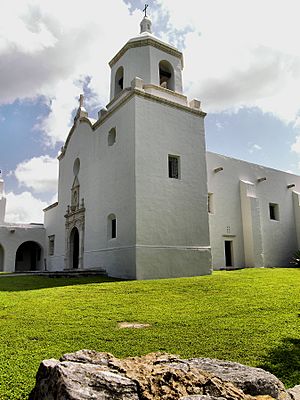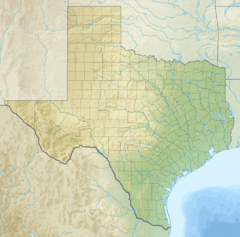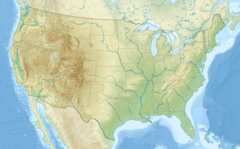Mission Nuestra Señora del Espíritu Santo de Zúñiga facts for kids
Quick facts for kids Mission Nuestra Señora del Espíritu Santo de Zúñiga |
|
|---|---|

The chapel of Mission Nuestra Señora del Espíritu Santo de Zúñiga
|
|
| Religion | |
| Affiliation | Roman Catholic |
| Location | |
| Location | Goliad, Texas |
| Architecture | |
| Architectural style | Spanish Colonial |
| Date established | 1722 |
| Completed | 1749 |
| Specifications | |
| Site area | 28 acres (11 ha) |
| Materials | stone and mortar |
| U.S. National Register of Historic Places | |
| Added to NRHP | August 22, 1977 |
| NRHP Reference no. | 77001446 |
|
U.S. Historic district
Contributing property |
|
| Designated | March 12, 2001 |
| Parent listing | Goliad State Park Historic District |
| Reference no. | 01000258 |
| June 28, 1983 | |
| 8200000287 | |
Mission Nuestra Señora del Espíritu Santo de Zúñiga, also known as Aranama Mission or Mission La Bahía, was a special place built by Spain in 1722. It was a Roman Catholic mission in a part of the New World called the Viceroyalty of New Spain. Its main goal was to teach Christianity to the native Karankawa people.
This mission, along with a nearby military fort called Presidio La Bahía, helped Spain protect its land claims. They wanted to keep France from taking over the area. The mission's third and final home is now part of Goliad State Park and Historic Site in Goliad, Texas.
Contents
Building the Mission: First Steps
The mission was first built in 1722 near Matagorda Bay. This spot was close to La Salle's Fort Saint Louis on Garcitas Creek. The mission and its fort were meant to guard the Texas coastline from the French. They also hoped to gather local Cocos, Copanes, and Cujanes people.
However, it was hard to convince the native people to stay at the mission. There were also problems and fighting with the Spanish soldiers. Because of these issues, the mission moved just four years later. It went to a better spot on the Guadalupe River. Today, you can see items from this early settlement at the Museum of the Coastal Bend in Victoria.
Moving to the Guadalupe River
In 1726, the mission moved near Victoria. It was set up among the Tamique and Aranama people in Mission Valley. To bring water from the river, they built dams and stone channels called acequias. A ranching outpost was also built from stone and mortar. This outpost was at Tonkawa Bank, about 12 miles down the river.
The military fort, the presidio, also moved and was built where Fernando de León's Ranch later stood. The mission did very well for 26 years. It grew enough grain and hay to trade with other Spanish settlements. This was also when cattle and horse ranching first began in the area. Even though it was successful, Spanish leaders suggested moving the mission again. They wanted to protect the area between Béxar and East Texas from the French and English.
Mission La Bahía in Goliad
In 1749, Mission La Bahía moved to its final location. This spot is now Goliad, Texas, on the San Antonio River. At first, temporary homes called "jacales" were built from logs and clay. Then, they started building strong outer walls and inner buildings from stone and mortar. These buildings were not finished until 1758.
Inside the stone walls, the mission had rooms for the priests and native families. There was also a granary for storing grain, workrooms, and a separate forge for metalwork. Just across the river, the military fort, Presidio La Bahía, was also built. The mission successfully taught and helped the Aranama, Piguique, Manos de Perro, Tamique, Tawakoni, and Tonkawa tribes. However, by the early 1830s, they faced attacks from Apaches and Comanches.
Texas's First Cattle Ranch
This mission became the first large cattle ranch in Texas. Around 1778, at its busiest time, it had almost 40,000 free-roaming cattle. These large herds of Texas longhorns and mustangs were cared for by the vaquero Indians from the mission. The people living at the mission also grew big crops of grain, fruit, and vegetables. They used these crops to feed themselves and to trade with others. Cattle and other livestock were also taken to and traded with other missions in East Texas and western Louisiana.
Mission's End and New Beginning
The mission was supposed to become a non-religious place in 1794. However, La Bahía continued to operate until Mexico became independent in 1821. Even then, two Franciscans (religious priests) chose to stay as local priests. Finally, in 1830, the mission officially became a non-religious site. Most of the native people had already left. The valuable mission lands were then bought by local Mexican and American settlers. The mission buildings themselves were given to the City of Goliad. People were even allowed to take stones from the old mission to use for building other things nearby. Between 1848 and 1856, the city rented the site first to a Baptist school and then to a Presbyterian school. But over time, the buildings slowly fell apart.
Restoring the Mission
The mission ruins became part of the new Goliad State Park in 1931. In 1933, a group called the Civil Works Administration started rebuilding the stone chapel and granary. They followed old drawings from the National Park Service and an architect from San Antonio named Atlee Ayres. Another group, the Civilian Conservation Corps Company 3822(V), helped finish restoring the mission between 1935 and 1941. They used money from the Works Progress Administration. More building work in the 1960s and 1980s helped the mission look like it did in 1749.
The mission was added to the National Register of Historic Places on August 22, 1977. Today, the park is managed by the Texas Parks and Wildlife Department.
See also



